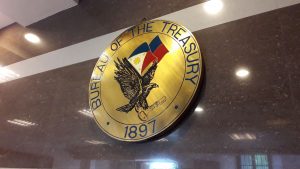




Policy rate views: Fed expected to do baby steps
 DOWNLOAD
DOWNLOAD

Inflation Update: Faster but full-year average within target
 DOWNLOAD
DOWNLOAD

Monthly Economic Update: Waiting on Jay Powell
 DOWNLOAD
DOWNLOAD


Treasury bill, bond rates may end mixed

Rates of Treasury bills (T-bills) and Treasury bonds (T-bonds) on offer this week could end mixed amid the peso’s continued weakness against the dollar.
The Bureau of the Treasury (BTr) on Monday will auction off PHP 15 billion in T-bills, or PHP 5 billion each in 91-, 182-, and 364-day papers.
On Tuesday, it will offer PHP 30 billion in reissued 20-year T-bonds with a remaining life of 19 years and 10 months.
T-bill and T-bond rates could track the mixed movements in secondary market yields following the peso’s continued depreciation against the dollar, Rizal Commercial Banking Corp. Chief Economist Michael L. Ricafort said in a Viber message.
At the secondary market on Friday, the 91- and 182-day T-bills went up by 9.36 basis points (bp) and 8.35 bps and 4.57 bps week on week to end at 5.8663% and 5.9804%, respectively, based on PHP Bloomberg Valuation Service Reference Rates data published on the Philippine Dealing System’s website.
Meanwhile, the yield on the 364-day T-bill went down by 1.7 bps to end at 6.0344%.
The 20-year bond also inched down by 0.31 bp week on week to close at 6.799%.
On Friday, the peso closed at PHP 57.65 per dollar, depreciating by 46 centavos from its PHP 57.19 finish on Thursday, Bankers Association of the Philippines data showed.
This was the peso’s worst finish since its PHP 58.19-per-dollar close on Nov. 10, 2022.
Year to date, the local unit has depreciated by PHP 2.28 from its PHP 55.37 finish on December 29, 2023.
Mr. Ricafort said the peso sank due to renewed tensions between Israel and Iran.
Meanwhile, the 20-year T-bond’s rate could end at 7% to 7.25%, with bids likely to be rejected as the market continues to be pressured by a hawkish US Federal Reserve, a trader said in an e-mail.
Top US central bank officials including Federal Reserve Chair Jerome H. Powell backed away on Tuesday from providing any guidance on when interest rates may be cut, saying instead that monetary policy needs to be restrictive for longer and further dashing investors’ hopes for meaningful reductions in borrowing costs this year, Reuters reported.
Fed policy makers have said since the start of the year that rate cuts are contingent on gaining “greater confidence” that inflation is moving towards the central bank’s 2% goal, but readings over the past few months show price pressures may even be moving in the opposite direction.
“The recent data have clearly not given us greater confidence and instead indicate that it’s likely to take longer than expected to achieve that confidence,” Mr. Powell told a forum in Washington, in what is likely to be his last public appearance before the April 30-May 1 policy meeting.
US central bankers are universally expected to leave rates unchanged at their upcoming meeting, but until early this month analysts and investors thought rate cuts would likely start with an initial quarter-percentage-point reduction at the Fed’s June 11-12 meeting, with two more cuts happening by the end of 2024.
The first rate cut is expected in September and the odds of a second cut are dwindling.
“If higher inflation does persist, we can maintain the current level of restriction for as long as needed,” Mr. Powell said. “At the same time, we have significant space to ease should the labor market unexpectedly weaken.”
In separate remarks earlier on Tuesday, Fed Vice Chair Philip Jefferson omitted any mention of rate cuts, and said the US central bank was ready to keep its tight monetary policy in place “for longer” if inflation fails to slow as expected.
In his last public remarks, on Feb. 22, Mr. Jefferson included what had been a staple of recent Fed communications – that “if the economy evolves broadly as expected, it will likely be appropriate to begin dialing back our policy restraint later this year,” a nod to the possibility of reducing the Fed’s benchmark overnight interest rate from the current 5.25%-5.5% range to account for a slowing pace of price increases.
Last week, the BTr raised PHP 15 billion as planned from the T-bills it offered as total bids reached PHP 39.831 billion or more than twice the amount on the auction block.
Broken down, the BTr borrowed PHP 5 billion as programmed from the 91-day T-bills as tenders for the tenor reached PhP 10.939 billion. The average rate for the three-month paper rose by 9.8 bps to 5.87% from the previous week. Accepted rates ranged from 5.824% to 5.895%.
The government likewise made a full PHP 5-billion award of the 182-day securities, with bids reaching PHP 13.632 billion. The average rate for the six-month T-bill stood at 5.973%, up by 8.8 bps, with accepted rates at 5.9% to 5.99%.
Lastly, the Treasury raised PHP 5 billion as planned via the 364-day debt papers as demand for the tenor totaled PHP 15.26 billion. The average rate of the one-year debt went up by 6.1 bps to 6.044%. Accepted yields were from 6.025% to 6.064%.
Meanwhile, the reissued 20-year bonds to be auctioned off on Tuesday were last offered on March 19, where the government made a full PHP 30-billion award of the papers at an average rate of 6.189%, 6.1 bps below the 6.25% coupon for the series.
The Treasury plans to raise PHP 195 billion from the domestic market this month or PHP 75 billion from T-bills and PHP 120 billion via T-bonds.
The government borrows from local and foreign sources to help fund its PHP 1.48-trillion budget deficit, which is capped at 5.6% of gross domestic product for this year. — A.M.C. Sy with Reuters
This article originally appeared on bworldonline.com





 By BusinessWorld
By BusinessWorld